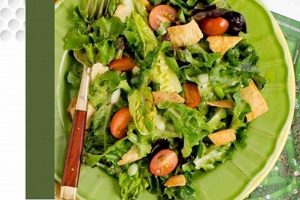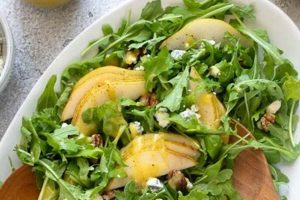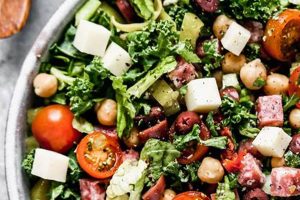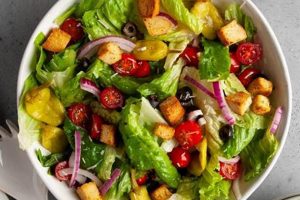A festive salad incorporating pomegranate arils offers a vibrant and refreshing addition to a holiday meal. This type of salad typically features winter greens, often including kale, spinach, or romaine lettuce, complemented by seasonal fruits like oranges or pears, and sometimes includes nuts such as pecans or walnuts. The bright red pomegranate seeds provide a visual pop of color and a tart-sweet flavor that contrasts beautifully with other ingredients. An example might include a spinach salad with sliced oranges, crumbled feta cheese, toasted pecans, and a pomegranate vinaigrette.
The inclusion of pomegranate arils offers several advantages. Nutritionally, pomegranates are rich in antioxidants and vitamins, contributing to the salad’s health benefits. Their vibrant color and juicy texture enhance the overall sensory experience, making the dish more appealing. Furthermore, the association of pomegranates with abundance and prosperity in some cultures lends a symbolic richness to their presence on the Christmas table. Historically, winter fruits and nuts have been valued for their availability during colder months, and their incorporation into festive dishes reflects this tradition.
This exploration of holiday salads will delve into specific recipe variations, highlighting ingredient combinations and preparation techniques. Nutritional information and cultural contexts will be further examined to provide a comprehensive understanding of this festive culinary tradition.
Tips for Festive Salads with Pomegranate Seeds
Optimizing flavor and presentation elevates a simple salad to a memorable dish. These tips offer guidance for creating a visually appealing and delicious festive salad featuring pomegranate arils.
Tip 1: Seed Removal: To efficiently extract pomegranate seeds, score the fruit and submerge it in a bowl of water. Gently loosen the arils underwater; they will sink while the pith floats, allowing for easy separation.
Tip 2: Ingredient Balance: Balance sweet and savory elements. Pair the tartness of pomegranate with creamy cheeses like goat cheese or feta, and incorporate toasted nuts for added crunch.
Tip 3: Green Selection: Consider a variety of greens. Baby spinach offers a mild flavor, while kale provides a heartier texture. Arugula adds a peppery note.
Tip 4: Dressing Choice: A light vinaigrette complements the delicate flavors. Citrus-based dressings, such as orange or lemon vinaigrette, pair well with pomegranate. A balsamic glaze can also add depth.
Tip 5: Visual Appeal: Distribute the pomegranate seeds evenly across the salad for a vibrant presentation. Consider other colorful additions, such as roasted beets or segmented oranges.
Tip 6: Timing is Key: To prevent the salad from becoming soggy, add the dressing and pomegranate arils just before serving. This maintains the crispness of the greens and the texture of the pomegranate.
Tip 7: Storage: Store prepared salad components separately and combine them just before serving to maintain optimal freshness and prevent the pomegranate seeds from bleeding color into other ingredients.
Attention to these details ensures a visually appealing and flavorful salad. The combination of fresh ingredients, balanced flavors, and thoughtful presentation contributes to a memorable dining experience.
By implementing these tips, one can create a festive salad that is both nutritious and aesthetically pleasing, a welcome addition to any holiday celebration.
1. Festive Visual Appeal
Visual appeal plays a crucial role in culinary experiences, particularly during holidays. A Christmas salad featuring pomegranate seeds leverages color and texture to enhance the festive atmosphere. The strategic placement of ingredients contributes significantly to the overall presentation and perceived enjoyment of the dish.
- Color Contrast:
The vibrant red of pomegranate arils stands out against the backdrop of green leafy vegetables. This contrast creates a visually striking presentation reminiscent of traditional Christmas colors. The deep green of kale or spinach, juxtaposed with the bright red arils, amplifies the festive aesthetic. This color interplay contributes to the overall celebratory mood.
- Textural Variety:
The glistening, jewel-toned pomegranate seeds offer a textural contrast to the leafy greens and other ingredients. This interplay of textures smooth arils, crisp greens, and potentially crunchy nuts enhances the sensory experience. The visual appeal extends beyond color to encompass the diverse textures, making the salad more engaging.
- Arrangement and Plating:
Thoughtful arrangement of ingredients further enhances the salad’s festive appeal. Evenly distributing the pomegranate seeds ensures their visual prominence. Incorporating other colorful elements, such as orange segments or dried cranberries, can amplify the festive theme. Strategic placement of ingredients contributes to a balanced and visually appealing composition.
- Garnish and Presentation:
A simple garnish can elevate the visual presentation. A sprig of fresh herbs, a light dusting of edible glitter, or a few strategically placed toasted nuts can add a touch of elegance and reinforce the festive theme. The choice of serving dish also contributes to the overall presentation, with clear glass bowls showcasing the vibrant colors effectively.
The visual elements contribute significantly to the perception of the salad as a festive dish, fitting for a Christmas celebration. The interplay of color, texture, and thoughtful arrangement transforms a simple salad into a visually captivating centerpiece, enhancing the overall dining experience.
2. Winter Ingredient Harmony
Seasonal ingredients contribute significantly to the distinctive character of a Christmas salad incorporating pomegranate seeds. “Winter ingredient harmony” refers to the careful selection and combination of ingredients that are typically available and at their peak flavor during the winter months. This principle emphasizes the use of produce that naturally complements each other, creating a balanced and flavorful salad suited to the festive season.
- Citrus Fruits:
Citrus fruits, such as oranges, grapefruits, and mandarins, reach peak season during winter. Their bright, acidic flavors provide a refreshing counterpoint to the sweetness of other ingredients, like winter squash or dried cranberries, and enhance the tartness of the pomegranate seeds. The addition of citrus segments adds visual appeal and contributes to a well-rounded flavor profile.
- Winter Greens:
Hearty winter greens like kale, spinach, and radicchio offer a robust base for the salad. Their slightly bitter notes contrast with the sweetness of fruits and the tartness of pomegranate, creating a more complex and nuanced flavor. These greens also provide a textural counterpoint to the pomegranate arils.
- Root Vegetables:
Roasted root vegetables, such as beets, carrots, and parsnips, provide earthy sweetness and a satisfying textural element. These ingredients add depth to the salad and complement the pomegranate’s juicy texture and vibrant color. The roasting process intensifies their natural sweetness, contributing to the overall flavor harmony.
- Nuts and Seeds:
Nuts and seeds, like pecans, walnuts, and pumpkin seeds, offer a textural contrast and contribute healthy fats, enhancing the salad’s nutritional value. Their earthy flavors complement the sweetness of fruits and the tartness of pomegranate. Toasting the nuts intensifies their flavor and adds a satisfying crunch.
The principle of winter ingredient harmony ensures that the Christmas salad with pomegranate seeds is not only visually appealing but also features a balanced and seasonally appropriate flavor profile. This approach maximizes the use of fresh, readily available produce, resulting in a dish that embodies the essence of winter flavors. The combination of these seasonal elements contributes to a salad that is both delicious and reflective of the festive season.
3. Nutritional Value
Nutritional value represents a significant aspect of a Christmas salad featuring pomegranate seeds. This dish offers more than just festive appeal; it contributes valuable nutrients beneficial for overall health. Understanding the nutritional components of this salad provides insight into its role in a balanced holiday diet.
- Antioxidant Properties:
Pomegranate arils are rich in antioxidants, particularly punicalagins and anthocyanins. These compounds protect cells from damage caused by free radicals, contributing to overall health and potentially reducing the risk of chronic diseases. The inclusion of other antioxidant-rich ingredients, such as leafy greens and berries, further enhances the salad’s protective properties.
- Vitamin and Mineral Content:
This type of salad provides a range of vitamins and minerals. Pomegranate seeds offer vitamin C and potassium. Leafy greens contribute vitamins A and K, as well as folate. Other ingredients, like nuts and seeds, provide additional minerals, including magnesium and zinc. The combined ingredients offer a diverse nutritional profile.
- Fiber Content:
Dietary fiber, abundant in leafy greens and some fruits, plays a crucial role in digestive health. It promotes regularity, aids in satiety, and can contribute to healthy cholesterol levels. The inclusion of ingredients like pomegranate seeds and vegetables contributes to the salad’s overall fiber content, supporting digestive well-being.
- Healthy Fats:
Incorporating nuts and seeds, or using an olive oil-based dressing, introduces healthy fats into the salad. These monounsaturated and polyunsaturated fats contribute to heart health and provide essential fatty acids. The type of fat present in the salad depends on the specific ingredients and dressing chosen.
The combined nutritional benefits of the individual components create a salad that supports overall well-being. This nutritional profile makes the Christmas salad with pomegranate seeds a healthful and flavorful addition to the holiday table, offering a refreshing counterpoint to richer holiday fare. The presence of antioxidants, vitamins, minerals, fiber, and healthy fats contributes to a dish that supports both enjoyment and nutritional needs during the festive season.
4. Cultural Significance
Cultural significance, often overlooked in culinary discussions, adds depth and meaning to dishes beyond their nutritional and aesthetic value. Examining the cultural context of a Christmas salad with pomegranate seeds reveals connections to traditions, symbolism, and historical practices that enrich the dining experience. This exploration delves into the cultural aspects associated with this festive dish.
- Symbolism of Abundance and Prosperity:
In some cultures, pomegranates symbolize abundance, fertility, and prosperity due to their numerous seeds. Their inclusion in a Christmas salad can be interpreted as a wish for good fortune in the coming year. This symbolic association adds a layer of meaning to the dish, transforming it from a simple salad into a representation of hope and abundance.
- Winter Solstice and Seasonal Celebrations:
Historically, winter solstice celebrations involved consuming foods that represented the promise of spring and the return of light. Pomegranates, with their vibrant color and association with life, fit within this context. Their inclusion in a Christmas salad connects the dish to broader themes of renewal and the cyclical nature of seasons. This link to ancient traditions provides a historical backdrop for the continued use of pomegranates in winter festivities.
- Regional Culinary Traditions:
In certain regions, pomegranates play a prominent role in traditional cuisine. Their inclusion in a Christmas salad may reflect specific regional culinary customs and preferences. This localized significance contributes to the diversity of Christmas culinary traditions, highlighting the role of specific ingredients in different cultural contexts. The use of pomegranates in a Christmas salad may indicate a connection to these regional culinary heritages.
- Contemporary Adaptations and Fusion:
Modern interpretations of Christmas salads often incorporate ingredients and flavors from diverse culinary traditions. The inclusion of pomegranate seeds may reflect this trend towards fusion cuisine, blending traditional elements with contemporary influences. This adaptability demonstrates the evolving nature of culinary traditions and the integration of diverse cultural elements into festive dishes.
Understanding the cultural significance associated with pomegranate seeds enriches the appreciation of this Christmas salad. It highlights how culinary traditions evolve and adapt, incorporating symbolic meanings and seasonal relevance. This exploration adds depth to the dining experience, connecting the dish to broader cultural themes and historical practices. The salad becomes more than a simple combination of ingredients; it represents a confluence of cultural influences and symbolic interpretations that contribute to the festive spirit of Christmas.
5. Preparation Simplicity
Preparation simplicity represents a key advantage of a Christmas salad featuring pomegranate arils, making it a practical choice for holiday gatherings. Time constraints often accompany festive preparations. A salad requiring minimal preparation allows hosts to focus on other aspects of the celebration without compromising the quality and appeal of the meal. The following facets illustrate the ease of preparing this festive dish.
- Minimal Pre-cooking Requirements:
Unlike many elaborate holiday dishes, this salad involves minimal pre-cooking. Most ingredients, such as leafy greens, fruits, and nuts, require little to no cooking, reducing preparation time significantly. Roasting root vegetables, if included, can be done in advance, further streamlining the process. This minimal need for cooking allows for quick assembly closer to serving time.
- Easy Assembly and Customization:
The salad’s assembly is straightforward. Ingredients are combined and tossed with a dressing just before serving, ensuring optimal freshness and preventing the salad from becoming soggy. Furthermore, the recipe is highly adaptable, accommodating variations based on ingredient availability and personal preferences. This flexibility simplifies the preparation process and allows for customization based on dietary needs or taste preferences.
- Make-Ahead Components:
Several components of the salad can be prepared in advance. Washing and drying greens, toasting nuts, and preparing the dressing can be done a day or two ahead. This advance preparation reduces the workload on the day of the event, allowing more time for other tasks. Storing these components separately maintains their freshness and simplifies final assembly.
- Simple Dressing Options:
The salad pairs well with simple vinaigrettes or light dressings, eliminating the need for complex sauce preparations. A basic vinaigrette can be whisked together in minutes, further simplifying the process. Pre-made dressings are also a viable option, further minimizing preparation time. The simplicity of the dressing complements the fresh flavors of the salad ingredients.
The inherent simplicity of preparation contributes to the appeal of this Christmas salad with pomegranate seeds. It offers a flavorful and visually appealing dish without demanding extensive time and effort, allowing hosts to manage holiday preparations efficiently. The ease of customization and the ability to prepare components in advance further enhance its practicality, making it a convenient yet elegant addition to the Christmas table. This combination of simplicity, flavor, and visual appeal positions the salad as an ideal choice for festive gatherings, freeing up valuable time for other holiday preparations and maximizing enjoyment of the celebration.
Frequently Asked Questions
This section addresses common inquiries regarding Christmas salads featuring pomegranate arils, providing clarity and practical guidance.
Question 1: Can other fruits be substituted for pomegranate in a Christmas salad?
While pomegranate arils offer unique color and flavor, substitutions are possible. Cranberries, raspberries, or chopped red grapes provide similar visual appeal and tartness. Consider flavor compatibility with other ingredients when substituting.
Question 2: What type of dressing best complements a Christmas salad with pomegranate seeds?
Light vinaigrettes, particularly citrus-based or balsamic, enhance the salad’s flavors without overpowering the delicate ingredients. A simple lemon vinaigrette or a light balsamic glaze complements the pomegranate’s tartness and the sweetness of other fruits.
Question 3: How can pomegranate seeds be prevented from staining other salad ingredients?
Adding pomegranate arils just before serving prevents staining. Storing them separately from other ingredients until the final assembly also minimizes color bleeding. This preserves the visual integrity of individual components.
Question 4: Can this salad be prepared in advance?
Certain components, like the dressing and toasted nuts, can be prepared in advance. However, assembling the salad just prior to serving ensures optimal freshness and prevents the greens from wilting. Store prepared components separately and combine them just before serving.
Question 5: What leafy greens work well in a Christmas salad with pomegranate?
Various leafy greens complement this salad. Spinach offers a mild flavor, while kale provides a heartier texture. Arugula adds a peppery note. Consider the overall flavor profile desired when selecting greens.
Question 6: How can one prevent the salad from becoming soggy?
Adding the dressing immediately before serving prevents the salad from becoming soggy. Ensuring greens are thoroughly dried before assembling the salad also contributes to maintaining crispness. Adequate drainage in the serving bowl helps prevent excess moisture accumulation.
Careful consideration of these points ensures a successful and enjoyable Christmas salad experience. Understanding ingredient compatibility, preparation timing, and storage methods contributes to a flavorful and visually appealing dish.
Exploring recipe variations further expands the possibilities for incorporating pomegranate arils into festive salads.
Conclusion
Exploration of the Christmas salad featuring pomegranate arils reveals a dish offering more than mere festive aesthetics. Nutritional value, derived from the combined benefits of diverse ingredients like leafy greens, winter fruits, and pomegranate seeds, contributes to a healthful addition to holiday meals. Considerations of color and texture enhance visual appeal, while the symbolic association of pomegranates with abundance adds cultural depth. Practicality, owing to simplified preparation and adaptable recipes, positions this salad as an ideal choice for holiday gatherings.
Culinary traditions evolve, reflecting cultural influences and seasonal availability. The Christmas salad with pomegranate seeds exemplifies this evolution, demonstrating the fusion of flavor, symbolism, and practicality. Further exploration of regional variations and ingredient adaptations offers continued potential for culinary innovation within this festive tradition.






